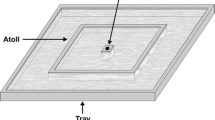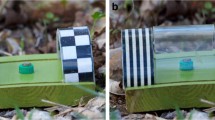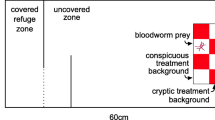Abstract
Using expectancy–violation methods, we investigated the role of working memory in the predatory strategy of Portia africana, a salticid spider from Kenya that preys by preference on other spiders. One of this predator’s tactics is to launch opportunistic leaping attacks on to other spiders in their webs. Focussing on this particular tactic, our experiments began with a test spider on a ramp facing a lure (dead prey spider mounted on a cork disc) that could be reached by leaping. After the test spider faced the lure for 30 s, we blocked the test spider’s view of the lure by lowering an opaque shutter before the spider leapt. When the shutter was raised 90 s later, either the same lure came into view again (control) or a different lure came into view (experimental: different prey type in same orientation or same prey type in different orientation). We recorded attack frequency (number of test spiders that leapt at the lure) and attack latency (time elapsing between shutter being raised and spiders initiating a leap). Attack latencies in control trials were not significantly different from attack latencies in experimental trials, regardless of whether it was prey type or prey orientation that changed in the experimental trials. However, compared with test spiders in the no-change control trials, significantly fewer test spiders leapt when prey type changed. There was no significant effect on attack frequency when prey orientation changed. These findings suggest that this predator represents prey type independently of prey orientation.




Similar content being viewed by others
References
Baddeley A (2012) Working memory: theories, models, and controversies. Annu Rev Psychol 63:1–29
Brown MF, Sayde JM (2013) Same/different discrimination by bumblebee colonies. Anim Cogn 16:117–125
Burge T (2010) Origins of objectivity. Oxford University Press, New York
Collett TS (1982) Do toads plan routes? A study of the detour behavior of Bufo viridis. J Comp Physiol 146:261–271
Cross FR, Jackson RR (2009) Cross-modality priming of visual and olfactory selective attention by a spider that feeds indirectly on vertebrate blood. J Exp Biol 212:1869–1875
Cross FR, Jackson RR (2010a) Olfactory search-image use by a mosquito-eating predator. Proc R Soc Lond B 277:3173–3178
Cross FR, Jackson RR (2010b) The attentive spider: search-image use by a mosquito-eating predator. Ethology 116:240–247
Cross FR, Jackson RR, Pollard SD (2008) Complex display behaviour of Evarcha culicivora, an East African mosquito-eating jumping spider. N Z J Zool 35:151–187
Curio E (1976) The ethology of predation. Springer-Verlag, Berlin
Delius JD, Hollard VD (1995) Orientation invariant pattern recognition by pigeons (Columba livia) and humans (Homo sapiens). J Comp Psychol 109:278–290
Dennett DC (1996) Kinds of minds: towards an understanding of consciousness. Simon and Schuster, New York
Epstein R (1982) Representation: a concept that fills no gaps. Behav Brain Sci 5:377–378
Gallistel CR (1989) Animal cognition: the representation of space, time and number. Annu Rev Psychol 40:155–189
Gallistel CR (1990) Representations in animal cognition: an introduction. Cognition 37:1–22
Giurfa M, Zhang S, Jenett A, Menzel R, Srinivasan MV (2001) The concepts of ‘sameness’ and ‘difference’ in an insect. Nature 410:930–933
Gómez J-C (2005) Species comparative studies and cognitive development. Trends Cogn Sci 9:118–125
Harland DP, Li D, Jackson RR (2012) How jumping spiders see the world. In: Lazareva O, Shimizu T, Wasserman EA (eds) How animals see the world: comparative behavior, biology, and evolution of vision. Oxford University Press, New York, pp 133–164
Hauser MD, MacNeilage P, Ware M (1996) Numerical representations in primates. Proc Natl Acad Sci USA 93:1514–1517
Howell DC (2002) Statistical methods for psychology, 5th edn. Wadsworth, Belmont
Jackson RR, Cross FR (2011) Spider cognition. Adv Insect Physiol 41:115–174
Jackson RR, Pollard SD (1996) Predatory behavior of jumping spiders. Annu Rev Entomol 41:287–308
Jackson RR, Clark RJ, Harland DP (2002) Behavioural and cognitive influences of kairomones on an araneophagic jumping spider. Behaviour 139:749–775
Jakob EM, Skow CD, Long S (2011) Plasticity, learning and cognition. In: Herberstein ME (ed) Spider behaviour: flexibility and versatility. Cambridge University Press, Cambridge, pp 307–347
Kamil AC, Bond AB (2006) Selective attention, priming, and foraging behavior. In: Wasserman EA, Zentall TR (eds) Comparative cognition: experimental explorations of animal intelligence. Oxford University Press, New York, pp 106–126
Kosslyn SM, Ganis G, Thompson WL (2003) Mental imagery: against the nihilistic hypothesis. Trends Cogn Sci 7:109–111
Land MF, Nilsson D-E (2012) Animal eyes, 2nd edn. Oxford University Press, Oxford
Markman AB, Dietrich E (2000) In defense of representation. Cognit Psychol 40:138–171
Maunsell JHR (1995) The brain’s visual world: representation of visual targets in cerebral cortex. Science 270:764–768
Neiworth JJ, Rilling ME (1987) A method for studying imagery in animals. J Exp Psychol Anim Behav Process 13:203–214
Palmer SE (1999) Vision science: photons to phenomenology. MIT Press, Cambridge
Peissig JJ, Goode T (2012) The recognition of rotated objects in animals. In: Lazareva O, Shimizu T, Wasserman EA (eds) How animals see the world: comparative behavior, biology, and evolution of vision. Oxford University Press, New York, pp 233–246
Pepperberg IM (2002) The value of the Piagetian framework for comparative cognitive studies. Anim Cogn 5:177–182
Pepperberg IM, Kozak FA (1986) Object permanence in the African grey parrot (Psittacus erithacus). Anim Learn Behav 14:322–330
Pylyshyn ZW (2003a) Explaining mental imagery: now you see it, now you don’t. Trends Cogn Sci 7:111–112
Pylyshyn ZW (2003b) Return of the mental image: are there really pictures in the brain? Trends Cogn Sci 7:113–118
Roberts WA, Feeney MC (2009) The comparative study of mental time travel. Trends Cogn Sci 13:271–277
Scharff N, Coddington JA (1997) A phylogenetic analysis of the orb-weaving spider family Araneidae (Arachnida, Araneae). Zool J Linn Soc 120:355–434
Shepard RN, Metzler J (1971) Mental rotation of three-dimensional objects. Science 171:701–703
Shettleworth SJ (2010) Cognition, evolution, and behavior, 2nd edn. Oxford University Press, New York
Tarsitano M, Andrew R (1999) Scanning and route selection in the jumping spider Portia labiata. Anim Behav 58:255–265
Tarsitano MS, Jackson RR (1997) Araneophagic jumping spiders discriminate between detour routes that do and do not lead to prey. Anim Behav 53:257–266
Whitehouse M (2011) Kleptoparasitic spiders of the subfamily Argyrodinae: a special case of behavioural plasticity. In: Herberstein ME (ed) Spider behaviour: flexibility and versatility. Cambridge University Press, Cambridge, pp 348–386
Wynn K (1992) Addition and subtraction by human infants. Nature 358:749–750
Acknowledgments
We thank Stephene Abok Aluoch, Godfrey Otieno Sune and Jane Atieno Obonyo for their assistance at ICIPE. We are grateful to G. B. Edwards (Florida State Collection of Arthropods, Gainsville, Florida), Ansie Dippenaar-Schoeman (ARC–Plant Protection Research Institute, Pretoria) and Charles Warui (National Museums of Kenya) for their help with spider taxonomy. We also gratefully acknowledge support of grants from the Foundation for Research, Science and Technology (UOCX0903), the Royal Society of New Zealand (Marsden Fund (M1096, M1079) and James Cook Fellowship (E5097)), the National Geographic Society (8676–09, 6705–00) and the US National Institutes of Health (R01-AI077722).
Author information
Authors and Affiliations
Corresponding author
Rights and permissions
About this article
Cite this article
Cross, F.R., Jackson, R.R. Specialised use of working memory by Portia africana, a spider-eating salticid. Anim Cogn 17, 435–444 (2014). https://doi.org/10.1007/s10071-013-0675-2
Received:
Revised:
Accepted:
Published:
Issue Date:
DOI: https://doi.org/10.1007/s10071-013-0675-2




